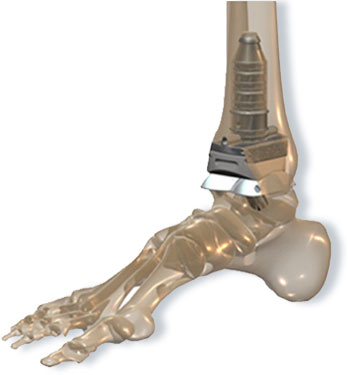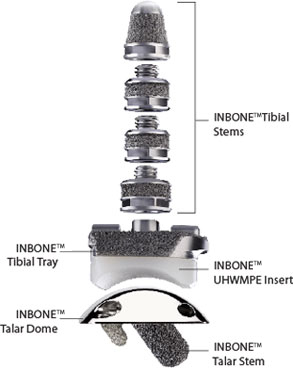Since its inception in 2005, the INBONE™ Total Ankle System has continued to be the most
distinctive and innovative total ankle replacement system on the market. By offering the first total ankle system that provides intramedullary instrumentation for accurate component positioning and the first ankle prosthesis with a choice of articulation geometries, Wright Medical continues to redefine innovation in ankle arthroplasty.
The INBONE™ Total Ankle System is a modular prosthesis installed via the first and only
intra-medullary alignment – PROPHECY™ INBONE™.
This is a major advancement for precise, reproducible installation.

The prosthesis has anchoring stems to secure it in place, within both the tibia and talus.
The INBONE™ Total Ankle System consists of a talar dome with a modular talar stem, a tibial tray, a four component tibial stem assembly that attaches to the tibial tray, and an ultra-high molecular weight polyethylene insert (UHMWPE).
All components are available in varying sizes to best match your anatomy.

There are several types of ankle arthritis: inflammatory rheumatoid, traumatic, and degenerative. Some can be well treated or at least temporized with various types of braces, orthotics, oral medications, and injections. When the pain of the arthritis begins to interfere with a patient’s life activities, frequently surgical intervention is needed.
The main-stay of ankle arthrosis has been joint arthrodesis, due to the moderately poor prosthetic survival of total ankle replacements. This is primarily due to the clinical results of early ankle designs. Therefore, arthrodesis has been the only choice for many surgeons and patients. Some patients have very good results from ankle fusion, although reports have shown that some patients eventually become limited by pain and degenerative changes elsewhere in the foot.
Over the last 40 years total joint replacement has been used successfully in three joints: the hip, the knee, and the shoulder. These successes came at the expense of many prosthetic failures. It was from solving the problems of those prosthetic failures, particularly those of the total knee, that the workable principles of total joint replacement arose. The INBONE™Total Ankle System is a third generation system and was designed with these proven principles of total joint arthroplasty in mind.
In the past, ankle replacements have suffered from poor fixation, since long tibial stems could not be placed into the ankle. In contrast to the knee, the ankle does not have the articulation range that would allow a long stem to be inserted. And, in contrast to the hip, the ankle cannot be dislocated to allow long stem access either. The only other choice is to put a large anterior window in the tibia so that a long stem could be dropped in. Although, the anterior window would allow a longer stem, it weakens the tibia at the same time, thereby defeating the purpose of a long stem.
The INBONE™ Total Ankle has addressed this problem by creating a patented, modular stem system. By dropping small, interconnecting stem pieces into the joint space, a surgeon can build a long tibial stem piece by piece. So the prosthesis gains fixation like that of knees and hips, without weakening the anterior portion of the tibia.